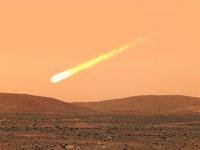Space prevents humans from exploring Mars
On October 19, 2014 the Mars orbit will be crossed by comet C/2013 A1. Astronomers around the world are very anxious as the comet will move very close to the Red Planet. This may cause a powerful meteor shower, which will create a threat to the operation of the terrestrial vehicles located on the Martian orbit.

C/2013 A1 was discovered by specialists of Siding Spring Observatory (New South Wales, Australia). First, scientists assumed that it will crash into the surface of Mars, but more precise calculations show that convergence will occur at a distance from 89 to 173 thousand kilometers. According to Bill Cooke of NASA's Marshal Space Center, no comet has ever been that close to the Earth. Over the entire history of astronomical observations the comet that approached our planet at the closest distance was observed in 1770, but even then it was 3.5 million kilometers away from the Earth.
If the astronomers' forecasts about C/2013 A1 are correct, then a gas-dust cloud surrounding the comet that can extend to a distance of hundreds of thousands of diameters of the comet's nucleus would envelop Mars and its environment, including satellites, both natural and artificial. According to the calculations by Cooke and his colleagues, over the two hours of the closest approach of the comet to the Red Planet, the density of cosmic dust in the atmosphere will increase 1-10 thousand times, which exceeds the indicators in low-Earth orbit. Meanwhile, the Indian Mars Orbiter Mission and American MAVEN should arrive at their destination before the comet meets Mars, and their fate in such extreme conditions would be unpredictable.
Both missions were launched in November of this year. Mars Orbiter Mission that weighs half a ton was launched from "Sriharikota" cosmodrome in India. Its main objective is to develop technologies that will be required to make subsequent interplanetary missions, including search for living organisms. The device has a sensor for methane detection, color image camera, pressure analyzer and a spectrometer. It is expected that next September the probe will go into the elliptical orbit of Mars (the distance from the planet's surface is from 500 to 80,000 kilometers).
MAVEN is a brainchild of NASA, and the abbreviation stands for Mars Atmosphere and Volatile EvolutioN. It was developed under the Mars Scout program and left the Earth on board the rocket Atlas-V launched from Cape Canaveral (Florida). The estimated flight time is 10 months. The device weighs 2.4 tons and uses solar panels. Once on the elliptical orbit around Mars, the probe is expected to use its eight scientific instruments to analyze the chemical composition and physical conditions in the upper atmosphere of the Red Planet and the near space. This will help the researchers to better understand the history of the Martian climate, in particular, understand how the planet lost its water and atmosphere billions of years ago.
However, there is no guarantee that everything will go smoothly, especially if Mars is visited by the notorious comet. "Any large particles moving at the speed of a comet is a threat to the spacecraft," said one of the MAVEN project staff Bruce Yakovski with the University of Colorado (Boulder, USA).
Despite the fact that MAVEN is rather reliable, the authors of the project at the moment are trying to assess the degree of risk to the system and develop the necessary measures to protect it. The machines located on the surface of Mars when the comet approaches will be in the best position. According to experts, they are unlikely to suffer.
On the contrary, the researchers will be able to take pictures of a "space show" when the sky flashes with meteors. According to the calculations, the intensity of the "shower" will be several million per hour. This will be a spectacular event. "If I had a chance, I would not mind going to Mars at that time," said Bill Cook.
Mark Lemmon of the University of Texas A&M (USA) is hopeful that rovers Opportunity and Curiosity working at this time on planet Mars will not only take photos but also will be able to measure the radio waves generated by a magnetic storm, which will allow to better study the Martian ionosphere.
Irina Shlionskaya
Pravda.Ru
Subscribe to Pravda.Ru Telegram channel, Facebook, RSS!


